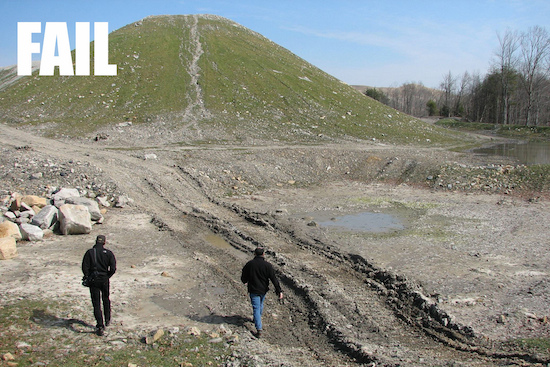Archive for November, 2014

Cross-posted from Appalachian Voices Front Porch Blog
It seems that whenever a picture of an active mountaintop removal mine site is posted online or shared on social media, someone steps in to comment that coal companies “put it back” or that, a few years after they reclaim the land “you won’t be able to tell the difference.”
For years, Appalachian Voices has been combating misleading claims about reclamation used by the industry and pro-coal politicians — especially the myth that mountaintop removal is necessary because it creates flat land for economic development. In a 2010 survey of mountaintop removal sites, we found that, of the 1.2 million acres of leveled Appalachian mountains, around 90 percent of reclaimed mine sites are not being used for economic development. In fact, most are just rocky grasslands not being used for anything at all.
Learn more about the lack of reclamation happening in this article which debunks the myth that you can put a mountain back together again after blowing it up, and see some of the extent of the damage on our reclamation fail page. The coal industry is blowing up mountains in Appalachia. They are not putting them back together again. The industry is polluting and burying streams, and they are not finding a way to fix them.
No comments yet » Leave your own...
 John Grisham is world famous for his best-selling legal thrillers. He must have been inspired by some of the powerful attorneys fighting mountaintop removal for his new novel, “Gray Mountain.” The book is set in Southwest Virginia, not far from our friends at Southern Appalachian Mountain Stewards.
John Grisham is world famous for his best-selling legal thrillers. He must have been inspired by some of the powerful attorneys fighting mountaintop removal for his new novel, “Gray Mountain.” The book is set in Southwest Virginia, not far from our friends at Southern Appalachian Mountain Stewards.
This novel is getting good reviews and will bring the issue of mountaintop removal mining to new audiences around the country and the world. As part of the book promotion, Grisham is sharing some of the facts about MTR with his 1.5 million Facebook fans if you’d like to follow along. The novel is currently at the top of the best-sellers list. We’re excited to welcome any new people who found this website or learned about the issue of mountaintop removal after reading his book!
If you’ve read the book, let us know what you think!
1 Comment » Leave your own...

News sources have been abuzz with the findings of a new study that shows that dust from mountaintop removal promotes the growth of lung tumors. Of course, communities have long known about the increased cancer they are facing, but this study was the first to prove the link through lab experiments on human lung cells.
This study and other overwhelming proof of the devastation caused by mountaintop removal prompted a high profile Editorial in the Washington Post.
A new study out of the University of Kentucky demonstrates that conductivity pollution from mountaintop removal mines hurts ecosystems’ ability to support wildlife and healthy streams. The study, published in the journal Biological Conservation, links mountaintop removal to low salamander populations. It reiterates once again what we already knew: that conductivity pollution threatens the health and diversity of Appalachian streams.
All this new information goes to show what we already knew – that mountaintop removal is irrevocably harming the land and people of Appalachia.
No comments yet » Leave your own...
Check out the Appalachian Voices Front Porch Blog as well as the New York Times for big news today:
Four years ago, groups, including Kentuckians For The Commonwealth, Appalachian Voices and the Waterkeeper Alliance, represented by the Appalachian Citizen’s Law Center took legal action against the Frasure Creek Mining in Kentucky for submitting false water monitoring reports, and now they are at it again, but this time the false reporting is even more extensive. Almost 28,000 violations of the Clean Water Act in what is likely the largest non-compliance of the law in its 42-year history.
From our friends at KFTC: If you are a coal company operating in eastern Kentucky, you can basically ignore the Clean Water Act because the primary enforcer is “asleep at the wheel.”
This article in the New York Times describes the ongoing failure by state officials to protect our water from mining pollution in Kentucky, and the ongoing failure by major coal companies to comply with the water quality laws.
In recent days, many news reports have focused on chronic and serious problems with mine safety enforcement and noncompliance. We can now add to that picture this new evidence of the coal industry’s routine evasion of environmental laws.
The true costs of these failures, as we all know, can be measured in terms of diminished health and safety of workers, residents and ecosystems.
No comments yet » Leave your own...
Cross-posted from TheAllianceforAppalachia.org
 At the end of October, The Alliance for Appalachia Economic Transition Committee, in conjunction with the group’s AppFellowKendall Bilbrey and Eric Dixon, AppFellow with the Appalachian Citizens Law Center, hosted a summit for folks across Central Appalachia to discuss and learn about the Abandoned Mine Land (AML) Fund and other potential strategies for cleaning up some of the toxic legacy left behind by the coal industry.A diverse group of stakeholders, including impacted community members, non-profit organizations, scholars, policy experts, lobbyists and scientists gathered for a packed day at Breaks Interstate Park at the border of Virginia and Kentucky to discuss the looming issue of Abandoned Mine Lands. At the end of October, The Alliance for Appalachia Economic Transition Committee, in conjunction with the group’s AppFellowKendall Bilbrey and Eric Dixon, AppFellow with the Appalachian Citizens Law Center, hosted a summit for folks across Central Appalachia to discuss and learn about the Abandoned Mine Land (AML) Fund and other potential strategies for cleaning up some of the toxic legacy left behind by the coal industry.A diverse group of stakeholders, including impacted community members, non-profit organizations, scholars, policy experts, lobbyists and scientists gathered for a packed day at Breaks Interstate Park at the border of Virginia and Kentucky to discuss the looming issue of Abandoned Mine Lands.
 The group’s hope is to create pathways for communities to influence mine cleanup, create jobs, and diversify our economy. What are the problems we are facing with the Abandoned Mine Lands Fund? What successes have communities had working with this fund? We’re excited to get these conversations moving in the region! Learn more in the press release or in the PowerPoint introduction to the project. The group’s hope is to create pathways for communities to influence mine cleanup, create jobs, and diversify our economy. What are the problems we are facing with the Abandoned Mine Lands Fund? What successes have communities had working with this fund? We’re excited to get these conversations moving in the region! Learn more in the press release or in the PowerPoint introduction to the project.
“The AML money needs to come back to where it came from, and where the healing is needed,” said Jane Branham of Southern Appalachian Mountain Stewards in Wise, County, VA and chair of The Alliance for Appalachia Coordinating Committee. “We have all these people out of work from mine closures. We can put people back to work healing the land – it’s not just good for the land, it’s good for the people, and would be a project our communities could really take pride in.”
Next steps are for an informative whitepaper to be released in early winter, highlighting the findings of this summit, research by AppFellows Kendall and Eric, and recommendations for the AML fund–all to be followed by campaign and project conversations.
|
|
No comments yet » Leave your own...










 John Grisham is world famous for his best-selling legal thrillers. He must have been inspired by some of the powerful attorneys fighting mountaintop removal for his new novel, “Gray Mountain.” The book is set in Southwest Virginia, not far from our friends at Southern Appalachian Mountain Stewards.
John Grisham is world famous for his best-selling legal thrillers. He must have been inspired by some of the powerful attorneys fighting mountaintop removal for his new novel, “Gray Mountain.” The book is set in Southwest Virginia, not far from our friends at Southern Appalachian Mountain Stewards.
 At the end of October, The Alliance for Appalachia Economic Transition Committee, in conjunction with the group’s
At the end of October, The Alliance for Appalachia Economic Transition Committee, in conjunction with the group’s  The group’s hope is to create pathways for communities to influence mine cleanup, create jobs, and diversify our economy. What are the problems we are facing with the Abandoned Mine Lands Fund? What successes have communities had working with this fund? We’re excited to get these conversations moving in the region! Learn more in the
The group’s hope is to create pathways for communities to influence mine cleanup, create jobs, and diversify our economy. What are the problems we are facing with the Abandoned Mine Lands Fund? What successes have communities had working with this fund? We’re excited to get these conversations moving in the region! Learn more in the 